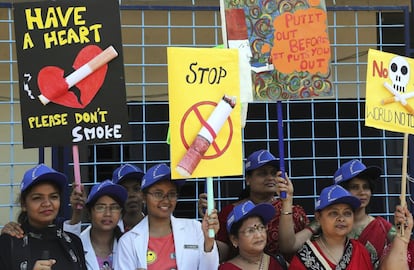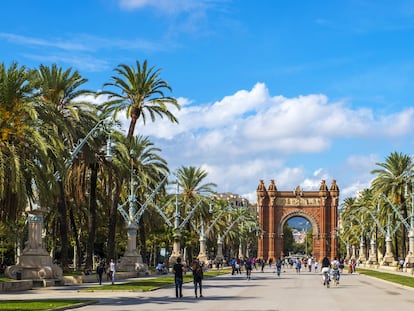Five inspiring cities and their exemplary efforts to deal with the silent urban killers
Mayors from around the world gathered in London to share public health strategies at the Summit of the Alliance of Healthy Cities: ‘There are lives that can be saved’

Ella Kissi-Debrah died when she was 9 from an asthma that was aggravated by the exposure to excessive air pollution in London. That is not what her death certificate stated, however – although it was recognized by the court some time later. That was a decade ago. Today, her mother, Rosamund Kissi-Debrah, is still in the fight to prevent premature deaths due to poor air quality. “There are lives that can be saved. I’m telling all the mayors: you have to do something. We want clean air to be a human right,” she pleaded before the delegations of 50 cities from all around the world, who gathered at the first Summit of the Alliance of Healthy Cities, held on March 15 in the British capital.
The vast majority of the 41 million annual deaths from chronic diseases (74% of all deaths in the world) happen among the elderly. However, according to data from the World Health Organization (WHO), 17 million people die prematurely each year from these non-communicable diseases before reaching 70. Of those deaths, 86% occur in low- and middle-income countries; poverty and a greater exposure to environmental risk factors (poor air quality) or unhealthy habits (an inadequate diet or drug abuse) go hand in hand, the agency points out.
“There are low-cost solutions for governments and other stakeholders to reduce common modifiable risk factors,” states the WHO. The goal established in the UN 2030 Agenda is to reduce by one third the probability of dying prematurely from a non-communicable disease, and cities, which bring together more than half of the world’s population, are one of the main battlefields against such factors.
“Polluted air is a silent killer. But it can be reduced. If national governments don’t do it, we mayors will have to assume that leadership,” stated Sadiq Khan, mayor of London, one of the 70 members of the Partnership for Healthy Cities, which is supported by the WHO and the Bloomberg Philanthropies and Vital Strategies organizations and has the goal of assisting cities in their unpopular war against these enemies of health. In that context, five initiatives were honored at the Summit for their actions in this regard, and will receive $150,000 to continue their work.
Montevideo (Uruguay): Guaranteeing a healthy diet for public employees
Uruguay (3.4 million inhabitants) is one of the countries where the percentage of overweight and obese people has increased fastest in the last decade: 65% of adults and almost 40% of children suffer from these diseases, which trigger and aggravate problems such as hypertension or diabetes. “Montevideo has a long history of defending the health of its population, starting in the 1990s with the ban on smoking in the City Hall building,” explains Mayor Carolina Cosse, one of the honorees for her latest effort to stop malnutrition: ensuring that public employees have access to healthy diets in their workplace.
We will exempt canteens in public institutions accredited as healthy from certain taxesCarolina Cosse, Mayor of Monevideo
After the introduction of the 2018 decree to reduce the consumption of salt in restaurants — having it on the table or offering it to customers is forbidden – city authorities have been working to increase the supply of healthy food through other means. On June 30, 2022, the Uruguayan capital approved new nutritional standards for the food and beverages served in its 48 public institutions and hospitals, as well as the restriction on the sale and advertising of ultra-processed products. Its latest measure, which earned it the recognition of the Partnership for Healthy Cities, is the Healthy Cafeterias program.
“We will exempt from certain tax burdens the cafeterias in public institutions that have been accredited as healthy by meeting certain conditions such as not displaying products with excess fat, sodium or sugar. They can sell them, but not display them,” explains Cosse. In addition, their menu should include inexpensive healthy options, created with the help of a nutritionist. “Now it’s up to us to carry out a great promotional campaign and convince them one by one. We can’t do it in schools because they are regulated by the federal government, but we are going to expand the program to the private sector.”
Bangalore (India): Creating tobacco-free spaces
According to the WHO, tobacco kills half of its users. Each year, there are more than eight million deaths in the world, of which 1.2 million are non-smokers who die as a result of exposure to second-hand smoke, which also increases the risk of lung cancer by 30% and that of suffering from coronary diseases by 25%.
Most measures to reduce consumption – the most effective being price hikes – are the responsibility of national governments, explains Kelly Henning, head of the Public Health program at Bloomberg Philanthropy. “But local authorities can implement very interesting interventions such as banning smoking in certain areas or advertising tobacco on city billboards,” she says. City administrators also have a responsibility to monitor compliance with the country’s anti-tobacco laws. The Indian city of Bangalore (population 13.6 million) was recognized for its determination in this regard.
Bangalore launched a training program for local police officers on how to detect and punish violators of the national anti-smoking law
A 2018 survey revealed that the anti-smoking law was only complied with in 10% of the city’s public spaces. With the support of the Partnership for Healthy Cities, the authorities came up with two strategies to deal with this: the mayor’s office launched a training program for police officers on how to detect and sanction offenders, and it also launched awareness campaigns in the local media. “Studies have shown that this can change individual behavior and build popular support for tobacco control policies. And they are quite profitable. Research confirmed that for every six cents spent, one person tried to quit smoking; for every $2.60, one did it; and for every $9.20, one death was prevented. Think about it for a moment: for less than $10, these ads can save a life,” says Dr. Vishal Rao, head of Head and Neck Surgical Oncology at the Healthcare Global Enterprise Hospital in Bangalore.
Among other actions, the Indian state of Karnataka, whose capital is Bangalore, launched the Stop Tobacco app earlier this month: to denounce a “violation against their right to health,” reports The Indian Times, citizens can upload a photograph of any smoker who violate the rules, so that a brigade can take the proper measures. The tool also makes it possible to denounce people who sell cigarettes outside schools.
Athens (Greece): Reducing overdose deaths
Kostas Bakoyannis, mayor of Athens, assures that his priorities are public health and protecting the most vulnerable population. With this in mind, he decided to replicate a model that has already been tested in other cities around the world to prevent overdose deaths among drug users (mainly homeless people) by opening supervised injection rooms with proper materials.

Naloxone is an opioid antagonist medication that acts as an antidote in case of an overdose. Administered in time, it can save the life of a user. However, in most countries, it can only be obtained with a prescription. Until very recently, Greece used to be one of them. Bakoyannis had a crucial role in advocating for the newly passed national law allowing the over-the-counter distribution of this treatment. His program to provide naloxone to relatives and close friends of addicts, with the aim of preventing their death in case of fatal acute poisoning, can now move forward without legal obstacles.
“We have one of the highest levels of drug abuse-related mortality in Europe,” explains the mayor. Despite the fact that the number of opioid users has decreased since 2008, the most recent data shows that in 2018 there were 274 drug-induced deaths in Greece: 38 per million inhabitants between the ages of 15 and 64, twice the European average of 16.7. “Now that we can ensure 24/7 accessibility to naloxone, we’re going to see a big change. It has been proven to work in other countries with a drastic reduction in overdose deaths,” he explains.
Mexico City (Mexico): Improving road safety
Every year, 1.25 million people die and 50 million are injured in traffic accidents. The WHO warns that this is the leading cause of death among persons aged 15 to 29. These incidents have increased in Mexico City, becoming a most significant public health problem: only in the third quarter of 2022, according to official data, 157 people died and 9,042 were injured – a 24% increase compared to the same period of the previous year.
The city’s actions to stop this have been recognized. The road safety plan promoted by Mayor Claudia Sheinbaum in 2021 includes the construction of 28 and a half kilometers of bike lanes, which has prompted a 275% increase in cyclists in the city, reports Bloomberg Philantropist. The committee that selected the winning cities also took into account the elaboration of a guide for safe school environments that offers strategies to optimize the design, management, maintenance and operation of accesses and routes, after discovering that 80% of all trips to school are made on foot or by public transport.

Vancouver (Canada): Using data to improve health
This Canadian city has been recognized for making public health data more inclusive and accessible by launching an online tool that tracks population health indicators, as well as by collaborating with urban indigenous communities to improve data management, states the Partnership for Healthy Cities.
Specifically, the program that made it win the financial award is its Healthy City Dashboard, created with the support of the Partnership, which monitors its progress in relation to 23 indicators of well-being: from the number of homeless people to the diet of the population or the amount of time they spend exercising.
Sign up for our weekly newsletter to get more English-language news coverage from EL PAÍS USA Edition
Tu suscripción se está usando en otro dispositivo
¿Quieres añadir otro usuario a tu suscripción?
Si continúas leyendo en este dispositivo, no se podrá leer en el otro.
FlechaTu suscripción se está usando en otro dispositivo y solo puedes acceder a EL PAÍS desde un dispositivo a la vez.
Si quieres compartir tu cuenta, cambia tu suscripción a la modalidad Premium, así podrás añadir otro usuario. Cada uno accederá con su propia cuenta de email, lo que os permitirá personalizar vuestra experiencia en EL PAÍS.
¿Tienes una suscripción de empresa? Accede aquí para contratar más cuentas.
En el caso de no saber quién está usando tu cuenta, te recomendamos cambiar tu contraseña aquí.
Si decides continuar compartiendo tu cuenta, este mensaje se mostrará en tu dispositivo y en el de la otra persona que está usando tu cuenta de forma indefinida, afectando a tu experiencia de lectura. Puedes consultar aquí los términos y condiciones de la suscripción digital.
More information
Archived In
Últimas noticias
There is as much life left to discover on planet Earth as that which is already known
Dozens presumed dead, around 100 injured in fire at Swiss Alps bar during New Year’s celebration
Is porn for women different from conventional porn? We spoke to those who make it
Cartagena de Indias is sinking: What can the city do to mitigate it?
Most viewed
- Reinhard Genzel, Nobel laureate in physics: ‘One-minute videos will never give you the truth’
- Sinaloa Cartel war is taking its toll on Los Chapitos
- David King, chemist: ‘There are scientists studying how to cool the planet; nobody should stop these experiments from happening’
- Oona Chaplin: ‘I told James Cameron that I was living in a treehouse and starting a permaculture project with a friend’
- The Interoceanic Train, the Mexican alternative to the Panama Canal











































